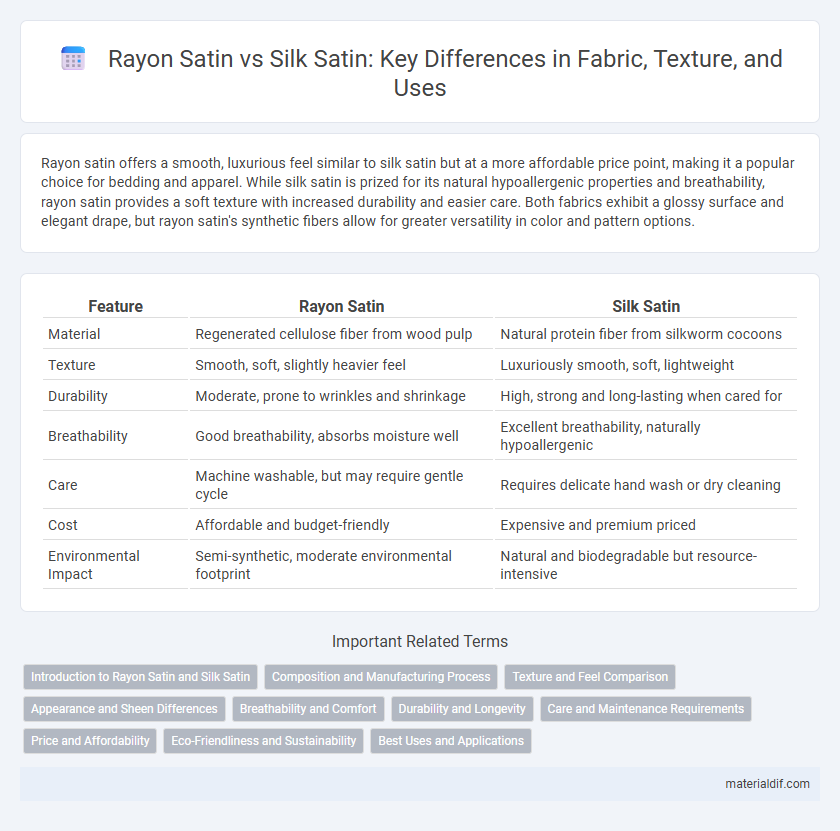Rayon satin offers a smooth, luxurious feel similar to silk satin but at a more affordable price point, making it a popular choice for bedding and apparel. While silk satin is prized for its natural hypoallergenic properties and breathability, rayon satin provides a soft texture with increased durability and easier care. Both fabrics exhibit a glossy surface and elegant drape, but rayon satin's synthetic fibers allow for greater versatility in color and pattern options.
Table of Comparison
| Feature | Rayon Satin | Silk Satin |
|---|---|---|
| Material | Regenerated cellulose fiber from wood pulp | Natural protein fiber from silkworm cocoons |
| Texture | Smooth, soft, slightly heavier feel | Luxuriously smooth, soft, lightweight |
| Durability | Moderate, prone to wrinkles and shrinkage | High, strong and long-lasting when cared for |
| Breathability | Good breathability, absorbs moisture well | Excellent breathability, naturally hypoallergenic |
| Care | Machine washable, but may require gentle cycle | Requires delicate hand wash or dry cleaning |
| Cost | Affordable and budget-friendly | Expensive and premium priced |
| Environmental Impact | Semi-synthetic, moderate environmental footprint | Natural and biodegradable but resource-intensive |
Introduction to Rayon Satin and Silk Satin
Rayon Satin is a semi-synthetic fabric made from regenerated cellulose fibers, offering a smooth, lustrous finish similar to natural fibers but at a more affordable cost. Silk Satin, derived from natural silk fibers produced by silkworms, boasts a luxurious sheen and exceptional softness prized in high-end fashion and bedding. Both fabrics share a glossy satin weave, but Rayon Satin provides versatility and breathability, while Silk Satin delivers unmatched elegance and durability.
Composition and Manufacturing Process
Rayon Satin is made from regenerated cellulose fibers derived from wood pulp, whereas Silk Satin is produced from natural protein fibers spun by silkworms. The manufacturing process for Rayon Satin involves chemically dissolving cellulose and then regenerating it into fibers, followed by a weaving technique that creates a smooth, glossy surface. Silk Satin, on the other hand, results from harvesting silk cocoons and carefully unwinding the fibers, which are then woven to achieve its characteristic shine and luxurious texture.
Texture and Feel Comparison
Rayon satin features a smooth, silky texture with a soft, flowing drape that mimics natural fibers, offering a cool and breathable feel ideal for warm climates. Silk satin provides a luxurious, naturally glossy finish with a slightly heavier weight, delivering a rich, smooth sensation that feels gentle and comforting against the skin. While both fabrics exhibit a lustrous sheen, silk satin tends to have a more refined, durable texture, whereas rayon satin balances elegance with affordability and ease of care.
Appearance and Sheen Differences
Rayon satin exhibits a smooth, glossy surface with a slightly more synthetic sheen compared to the natural, lustrous glow of silk satin. Silk satin's appearance is characterized by its rich depth of color and reflective brilliance, creating an elegant and luxurious finish. The sheen of rayon satin tends to be more uniform and less subtle, while silk satin offers a softer, more complex shimmer due to the protein fibers in silk.
Breathability and Comfort
Rayon satin offers superior breathability compared to silk satin due to its semi-synthetic cellulose fibers that allow better air circulation, making it ideal for hot climates. Silk satin, while luxurious and smooth, tends to retain heat and moisture, resulting in less comfort during extended wear. For those seeking a balance of softness and enhanced airflow, rayon satin is a more comfortable and breathable choice.
Durability and Longevity
Rayon satin offers moderate durability compared to silk satin, which is known for its delicate fiber structure that requires careful handling to maintain longevity. Silk satin tends to have a shorter lifespan due to its natural protein fibers, whereas rayon satin, made from regenerated cellulose fibers, can withstand more frequent wear and washing. Both fabrics demand specific care, but rayon satin generally provides a more resilient option for everyday use without sacrificing the luxurious satin finish.
Care and Maintenance Requirements
Rayon satin requires gentle hand washing in cold water and air drying to maintain its smooth texture and prevent shrinkage, while silk satin demands more delicate care with mild detergents and professional dry cleaning to preserve its natural fibers and sheen. Both fabrics should be kept away from direct sunlight to avoid color fading, but silk satin is especially prone to damage from excessive heat and moisture. Proper storage in a cool, dry place and avoiding rough handling are essential to extend the lifespan of both rayon satin and silk satin garments.
Price and Affordability
Rayon satin offers a budget-friendly alternative to silk satin, making it popular for affordable yet elegant clothing and home textiles. While silk satin commands a premium price due to its natural fiber and luxurious feel, rayon satin replicates the smooth sheen and softness at a fraction of the cost. This affordability makes rayon satin ideal for consumers seeking the aesthetic of silk without the high price tag.
Eco-Friendliness and Sustainability
Rayon satin and silk satin differ significantly in eco-friendliness and sustainability, with rayon being a semi-synthetic fiber derived from cellulose, often produced using chemical-intensive processes that raise environmental concerns. Silk satin, a natural protein fiber from silkworms, boasts biodegradability and minimal chemical treatment, making it more sustainable in terms of biodegradability and resource use. However, advancements in eco-friendly rayon production, such as the lyocell process, are improving its environmental footprint compared to traditional methods.
Best Uses and Applications
Rayon satin offers a cost-effective and breathable alternative to silk satin, making it ideal for everyday apparel such as blouses, dresses, and linings due to its smooth texture and durability. Silk satin is favored in luxury fashion and high-end lingerie because of its natural fiber composition, lustrous sheen, and superior softness, providing an elegant drape and comfort. Both fabrics excel in formalwear, but rayon satin is preferred for budget-conscious projects while silk satin suits premium, delicate applications.
Rayon Satin vs Silk Satin Infographic

 materialdif.com
materialdif.com